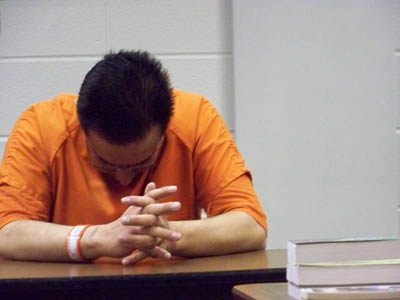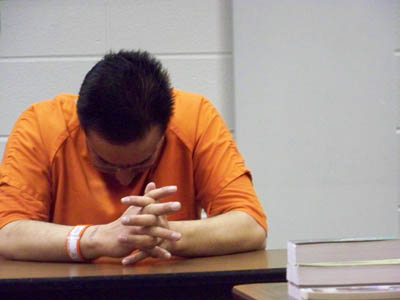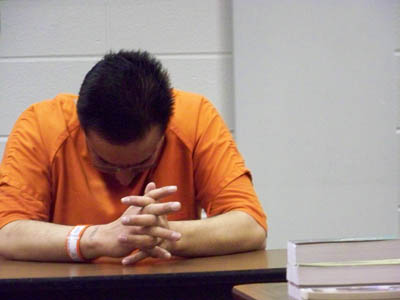
A detainee prays at the McHenry County Correctional Facility in Woodstock, Ill., where more than half of the inmates are being held on immigration violations.

A detainee prays at the McHenry County Correctional Facility in Woodstock, Ill., where more than half of the inmates are being held on immigration violations.

A detainee prays at the McHenry County Correctional Facility in Woodstock, Ill., where more than half of the inmates are being held on immigration violations.
(UNDATED) For Jarvis Masters, his Buddhist journals bring peace from the panic he feels on death row in California’s San Quentin State Prison.
An article entitled “Life in Relation to Death” by a Tibetan Buddhist lama helps him learn the Buddha’s ways. He wears a string of 108 beads, called a Mala, around his neck to help him concentrate on his meditations.
Masters, 47, adopted Buddhist practices shortly after he was convicted of murdering a prison guard 25 years ago and sentenced to death. Awaiting execution, he relies on the sparse copies of Buddhist materials in the prison’s visiting room to come to terms with his fate.
“Prisoners need to have access to whatever will help them become a better human being, to learn to love more, to forgive, and to ask for forgiveness,” Masters wrote in an e-mail.
But from Protestant texts to Wiccan incense, state and federal officials are trying to determine which religious materials belong behind bars. Recent cases show freedom-to-practice laws are unevenly enforced, and advocates are fighting to ensure corrections officials uphold prisoners’ rights.
In Virginia, jail officials confiscated biblical passages sent from a mother to her incarcerated son; in Louisiana, a Bible lined with several hacksaw blades passed through security. Those cases, and others, have authorities struggling to decide whether current guidelines are too strict or not strict enough.
The Federal Bureau of Prisons (BOP) policy, which applies to federal prisons, states that “inmates will be permitted to receive and retain publications which do not threaten security, good order, or discipline of the institution, or that may facilitate criminal activity, or are otherwise prohibited by law.”
Holly Hollman, general counsel for the Baptist Joint Committee for Religious Liberty, says religious freedom is especially important for inmates.
“Prisoners, more than anyone, would need the comfort and the hope that many people find in the exercise of their faith,” Hollman said. “Religion provides at least (the assurance) that people are connected to God.”
Last year, Congress passed the Second Chance Act, which allows BOP to restrict only those materials “that seek to incite, promote or otherwise suggest the commission of violence or criminal activity.” In March, Hollman and seven other religious leaders argued against a proposed change that would allow officials to ban materials that “could” promote violence.
Confusion over those rules once led BOP officials to ban megachurch pastor Rick Warren’s best-seller, “The Purpose Driven Life,” while the New Testament book of Acts – in which St. Paul breaks out of jail – was allowed to stay.
“You can distort Bible passages to mean anything you want them to mean,” said the Rev. Barry Lynn, executive director of Americans United for Separation of Church and State. “Officials need to take a deep breath and consider if there is any realistic danger.”
Other laws, including the 2000 Religious Land Use and Institutionalized Persons Act and the 1996 Prison Litigation Reform Act, attempt to standardize regulations for state and federal prisons. The problem, observers say, is not the law itself, but uneven enforcement.
“In the past, individual wardens could make these determinations, but consistency was an issue,” said Pam Laborde, spokeswoman for the Louisiana Department of Corrections. “A publication may be allowed at one facility and rejected at another.”
In the case at Rappahannock Regional Jail in Stafford, Va., officials are accused of confiscating a Christian magazine article and biblical passages sent from a mother to her imprisoned son. Authorities informed the son that the material was censored because of jail policies against “Internet pages” and “religious material from home.”
Though some say these are egregious reasons for censorship, jail officials say the policies are needed to ensure that documents are not embedded with undetectable drugs, such as an acid hit.
“Public safety is our No. 1 mission in the Department of Corrections,” Laborde said. “However, we strongly believe in an offender’s right to practice his (or) her faith.”
Laborde said all corrections departments try to balance security with laws that demand the “least restrictive means” in censorship. When that doesn’t work, there is always an appeals process.
David Shapiro, an attorney with the ACLU National Prison Project, said appeals processes are tilted in favor of wardens, not inmates.
“Prisons can design almost any grievance systems they want,” Shapiro said. “If the prisoner doesn’t dot every`i’ and cross every`t’ and meet every deadline and step of that process, he or she loses the right to go to court. It enables prisons to operate with impunity.”
Christine Shimrock, a Catholic chaplain at Connecticut’s Lebanon Correctional Institution, said the warden determines how much latitude she has as the religious liaison between administrators and inmates.
“(If you have) a warden who doesn’t value religious programming, then you find yourself battling even the simplest requests guaranteed by law,” she said. But more times than not, “wardens are very, very careful about making sure that religious rights are honored in their prison.”
(OPTIONAL TRIM FOLLOWS)
Even so, Barbara McGraw, a religion and social ethics professor at Saint Mary’s College of California, said religious accommodations for mainstream religions typically take priority over minority groups, such as Sikhs and Hindus. She recalls a state institution where lit candles were allowed only for Catholics, and when other groups complained, the institution banned candles for everyone.
“When religion is allowed, (practices) exposing the prisoner’s inherent `sinful nature’ are often favored,” she said – in other words, more Calvinist depravity than Quaker notions of repentance and reform.
Meanwhile, as Masters petitions the California Supreme Court for an appeal, his memoir, “That Bird Has My Wings,” which will be published in October, describes how Buddhism dims his pain and suffering on death row.
“I have come to realize that one can find freedom even while living in prison. Many people walking the streets are in their own`prison,”‘ he said. “But if you can find peace in your heart, no matter where you are, this is the greatest freedom.”




